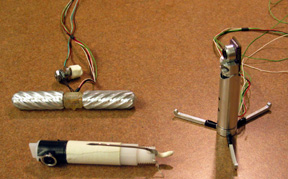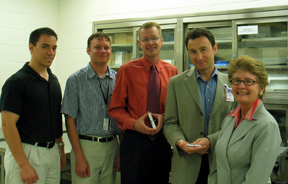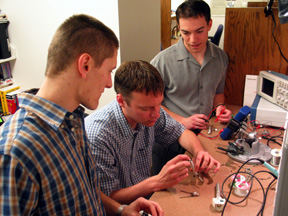 |
Early designs of the mini robots. |
But, these tiny-wheeled robots – slipped into the abdomen and controlled by surgeons hundreds of kilometers away – may be giants in saving the lives of roadside accident victims and soldiers injured on the battlefield.
Each camera-carrying robot — the width of a lipstick case — would illuminate the patient’s abdomen, beam back video images and carry different tools to help surgeons stop internal bleeding by clamping, clotting or cauterizing wounds.
Sound far-fetched? Not for physicians and engineers at the University of Nebraska Medical Center and University of Nebraska-Lincoln, who already are turning the sci-fi idea into reality with a handful of miniature prototypes.
 |
From left: Mark Rentschler, Jason Dumpert, Shane Farritor, Ph.D., Dmitry Oleynikov, M.D., and Marsha Morien. Not present: Dr. Steve Platt. |
“This work has the potential to completely change the minimally invasive surgery landscape,” said Dmitry Oleynikov, M.D., director of education and training for the minimally invasive and computer-assisted surgery initiative. “This is just the start of things to come regarding robotic devices at work inside the body during surgery.”
It’s a stark contrast to existing laparoscopic techniques, which allow surgeons to perform operations through small incisions. The benefits of laparoscopy are limited to less complex procedures, however, because of losses in imaging and dexterity compared to conventional surgery.
“These remotely controlled in vivo robots provide the surgeon with an enhanced field of view from arbitrary angles, as well as provide dexterous manipulators not constrained by small incisions in the abdominal wall,” Dr. Oleynikov said.
In fact, the view is better than the naked eye, he said, because the in-color pictures from the roaming robots are magnified 10x.
 |
Members of the design team work on the miniature robots. |
The UNMC and UNL team also plans to soon test a final prototype of a mobile biopsy robot designed to take samples of tissue. In addition, the design team is making modified robots that can be inserted into the stomach cavity through the esophagus.
The 3-inch long, aluminum-cased robots contain gears, motors, lenses, camera chips and electrical boards. “Three inches seems to be our limit at the moment because of the electrical components we use,” said designer Mark Rentschler, a Ph.D. candidate in biomedical engineering at UNL. “If we were to make 1,000 robots we would be able to afford customized electrical components that would reduce the size of the robot by half.”
The design team said initially the mini-robots will be single-use devices, although they eventually may be able to be sterilized for multiple use.
The group intends to create a local, spin-off company and then seek FDA approval of the devices, which would be applicable for any laparoscopic or minimally invasive surgery – from gall bladder to hernia repair.
“We’re the first in the world to come up with this technology,” Dr. Oleynikov said. “Everybody knows this is a Nebraska effort.”
Even so, the implications are far-reaching. NASA plans to use the robots next spring for simulated, extreme environment training. Astronauts will practice surgical skills and procedures in a submarine off the Florida coast.
“It’s hard to teach an astronaut to be a surgeon,” Dr. Oleynikov said. “I’ll be the surgeon and they will be the technologists. Devices such as this could be invaluable on long duration space flights where medical personnel and equipment is sparse.”
Meanwhile, the UNMC and UNL team is working with a group in the United Kingdom, which is pushing for clinical studies in the near future, perhaps within a year, Dr. Oleynikov said.
“Our family of tiny-wheeled robots has the potential to revolutionize the minimally invasive surgery field,” Dr. Oleynikov said. “It will replace standard surgery and at some point the surgeon’s hands won’t need to be in the body at all.”